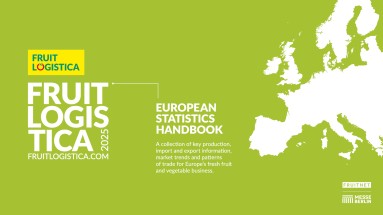Page content
"The real winner is the consumer"
What is currently driving the European fruit and vegetable industry?
Clearly weather, weather conditions and climate. In 2024, it was too wet in large parts over a long period of time, with extreme flooding like in Valencia. But there were also two waves of flooding in Germany. At the other extreme, heatwaves and drought also occurred regionally. Political regulations, such as the cancellation of subsidies for agricultural diesel, caused considerable displeasure. And, of course, political uncertainty is an issue. But also the labour shortage and labour costs. Fewer and fewer active ingredients are being authorised for crop protection products, which reduces the choice and increases the risk of resistance.
What surprised you when compiling the European Statistics Handbook?
The impact of the extreme weather events is not yet strongly reflected in the figures. I would have expected significant cuts in citrus fruit, especially for produce from Spain. I would have expected a smaller vegetable harvest in Germany and Central Europe. However, it remains to be seen whether the unfavourable weather conditions during storage will lead to quality problems and thus high sorting losses.
Who is doing really well at the moment?
There are no clear winners and losers in the individual European countries. But in the retail sector, it is certainly the discounters. Due to high inflation rates, consumers are looking at the price. In Germany, the discounters' share of fruit and vegetable purchases has risen again to around 52 per cent.
What does this mean for consumers?
He is the real winner. They have a huge choice of where to buy what and when. And as competition in retail is often based on price, especially when it comes to fresh produce, there are many special offers. Topics such as organic, regionality and sustainability in general were less of a focus for many consumers in 2024. Economic considerations dominated consumer behaviour.
Who loses?
Producers are somewhat on the losing side because they often bear the entire risk for production planning, weather conditions and possible cancellations. With German glasses on, I see the danger that we will lose out in European competition. Production costs are high and there are huge bureaucratic hurdles. The number of farms is declining and there is a lack of succession planning for farm managers.
What is the situation at international level?
We are looking in vain for the golden production country where everything is great. Everyone faces challenges in terms of weather and climate. With overseas goods, there is the problem of ship transport: political uncertainties, storms are increasing, detours have to be taken. Delays occur. New diseases and pests are also emerging, for example in bananas. And the availability of water is a major issue.
How do you see 2025?
The risk of producing sustainably, safely and reliably has increased significantly. The key challenges will be: How can I mitigate the consequences of extreme weather events and adapt production methods, for example by breeding resistant varieties. Plant protection products also play a role here. Another topic that will occupy the industry in the future is multi-risk insurance, so that producers do not have to bear the entire loss alone in the event of hailstorms or other weather extremes. Alternative, sustainable packaging methods are also important to ensure that the product is protected, visually appealing and transparent enough for consumers to see what they are buying. Last but not least, the industry needs to make more of the trend towards vegan and vegetarian diets. So far, the focus here has often been on highly processed substitute products. Yet fresh fruit and vegetables offer so many options with high standards. It would be desirable for fruit and vegetables to benefit more in the future.


